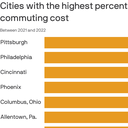Your commute is hundreds of dollars more expensive this year

Rising prices for gas and auto insurance mean the average American is now paying $2,914 a year to commute, up $757 — or 35% — from last year, according to a new report.
Why it matters: The sheer expense of getting to work is not just hurting our bank accounts — it's contributing to wrangling between workers and employers over returning to the office.
- It's also leading to debate over whether companies should pick up the tab.
- Legislation poised to become law in Philadelphia will require firms with more than 50 people to offer commuter benefits.
Driving the news: Rising fuel prices are the biggest contributor to higher commuting costs (to no one's surprise). U.S. commuters will spend an average of $657 on gas this year — up 58% from last year, according to a calculation by a website called Overheard on Conference Calls.
- The costs of auto insurance and wear-and-tear are up 8% this year, more in line with the overall rate of inflation.
- Overheard on Conference Calls — which reviews office equipment (like desk chairs and standing desks) and says its aim is to "make work more enjoyable" — looked at commuting prices in 96 U.S. cities.
New York City takes the prize for the most expensive commute: At $4,040, this year's got-to-get-to-work expenses are 47% higher than last year's, which amounts to an extra $1,290 out-of-pocket.
- Second place is Rochester, New York ($3,984, also up 47%), followed by Albany ($3,946, or 46%), Jacksonville, Florida ($3,933, or 40%) and Orlando, Florida ($3,922, or 39%).
- The 5 cities with the highest percentage increase in commuting costs: Pittsburgh (60.1%), Philadelphia (59.9%), Cincinnati (59.1%), Phoenix (58.1%) and Columbus, Ohio (58.0%).
The big picture: While rising commuter costs are lousy for everyone — particularly people who can't work remotely, and who tend to have lower-paying jobs — there are some silver linings:
- Some transportation operators — like New York City's MTA — are staving off fare hikes in an attempt to coax riders back after ridership plummeted during the pandemic.
- Cities in Silicon Valley and elsewhere are investing in public transportation — including in electric trains.
- And the worker shortage has been playing its part in offsetting the pain: "Rising gasoline prices are prompting more companies to offer fuel stipends, gift cards and other benefits, including continued work-from-home privileges, as they try to retain employees," per the Wall Street Journal.
What's next: Gas prices have been dropping, but it remains to be seen whether that'll translate to lower commuting costs, given current trends in inflation and driving-related expenses.
Methodology: To find the average annual cost of commuting, Overheard on Conference Calls researchers used census and government survey data to find the average commute distance in miles (roundtrip) for 96 cities.
- They multiplied that by the cost of gas and the cost of wear and tear to find a daily commute cost.
- That was multiplied by a true working day cost (total business days minus federal holidays and average PTO taken) to find the annual yearly cost for the car and gas. The average cost of auto insurance was added to get the total annual cost.